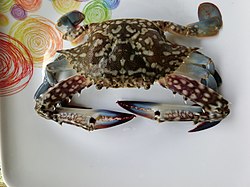Biology:Portunus armatus
| Portunus armatus | |
|---|---|

| |
| Scientific classification | |
| Domain: | Eukaryota |
| Kingdom: | Animalia |
| Phylum: | Arthropoda |
| Class: | Malacostraca |
| Order: | Decapoda |
| Suborder: | Pleocyemata |
| Infraorder: | Brachyura |
| Family: | Portunidae |
| Genus: | Portunus |
| Species: | P. armatus
|
| Binomial name | |
| Portunus armatus (A. Milne-Edwards, 1861)
| |
Portunus armatus is a species of crustacean, a swimming crab in the family Portunidae found in Australia and eastwards to New Caledonia.[1] Common names include blue swimmer crabs, Blue manna, Blueys,[2] and Jennies (for females).[3] The species was originally considered as a geographic variation of Portunus pelagicus, however in 2010 the Portunus pelagicus species was reviewed using DNA, as well as physical characteristics including measurements and four species recognised: Portunus pelagicus, Portunus armatus, Portunus reticulatis and Portunus segnis. The range of Portunus armatus overlaps with Portunus pelagicus in the Northern Territory of Australia.[1]
Portunus armatus is a commercially and recreationally important fishing crab. Although it is resilient to overfishing, collapse of populations have occurred in some areas where there has been adverse environmental conditions and heavy fishing.[4]
These crabs inhabit waters from 50 m depth through to the intertidal zone, moving from shallower to deeper water in winter. Individuals in estuaries will move to the ocean in response to fresh water from winter rains.[4] They prefer areas with flat muddy or sandy bottoms with seagrass or algae.[1] They reach maturity in one year,[3] and live to an age of 2-3 years.[4] Maximum size across the carapace is around 200mm[1] to 250mm,[2] with up to 800mm maximum claw span.[2]
The color is variable, but the carapace of males is generally dark blue-green with spots overall and bands at the front, whereas females are similarly pattered but brownish and with the tips of the claws deep brownish red.[1] Behind the eye on each side of the carapace, is a total of 9 teeth or spines, including one long spine at the side.[4] The last limb ends in a flat paddle.
Diet is mostly small fish and other crustaceans, molluscs, worms, and less so algae and seagrass.[2]
References
- ↑ 1.0 1.1 1.2 1.3 1.4 Lai, Joelle C Y; Ng, Peter K L; Davie, Peter J F (2010). "A revision of the Portunus pelagicus (Linnaeus, 1758) species complex (Crustacea: Brachyura: Portunidae), with the recognition of four species". The Raffles Bulletin of Zoology 58 (2): 199–237. https://www.researchgate.net/publication/228663959.
- ↑ 2.0 2.1 2.2 2.3 "Blue Swimmer Crabs". Department of Primary Industries and Regional Development. 2021. https://www.fish.wa.gov.au/species/blue-swimmer-crabs/pages/default.aspx.
- ↑ 3.0 3.1 "Blue Swimmer Crab". Australian Museum. 2020. https://australian.museum/learn/animals/crustaceans/blue-swimmer-crab.
- ↑ 4.0 4.1 4.2 4.3 Johnston, D.; Yeoh, D.; Harris, D.; Fisher, E. (2020). "Blue Swimmer Crab (Portunus armatus) Resource in the West Coast Bioregion, Western Australia Part 1: Peel-Harvey Estuary, Cockburn Sound and Swan-Canning Estuary". Department of Primary Industries and Regional Development. https://www.fish.wa.gov.au/Documents/research_reports/frr307.pdf.
Wikidata ☰ Q14159710 entry
 |

